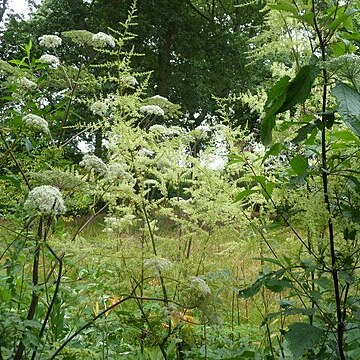Herbs 0.6-2.5 m tall. Stems brown long glandular hairy. Leaves 2-or 3-pinnately compound; common petiole and petiolules brown long pilose; leaflets lanceolate, narrowly to broadly ovate, elliptic or broadly so, rhombic-elliptic, narrowly rhombic-obovate, or obovate, 4-14.5 × 1.7-8.4 cm, abaxially brown long pilose and glandular hairy along veins, adaxially sparsely brown glandular strigose, base obliquely cordate or rounded to cuneate, margin doubly serrate, apex acuminate. Panicle to 42 cm, many flowered; branches 1-18 cm, brown crisped glandular hairy; bracts 3, subelliptic, 1.1-1.4 × 0.2-0.6 mm, brown pilose, margin entire or dentate; pedicels 0.6-1.8 mm. Sepals 4 or 5, green, ovate or elliptic to oblong, 1.2-1.5 × ca. 1 mm, submembranous, abaxially subconvex, adaxially subconcave, glabrous, 1-veined. Petals absent, sometimes 1(-5) and obsolescent. Stamens 5-10(-12), 0.2-2.4 mm. Pistil ca. 2 mm; carpels 2, base connate; ovary subsuperior; styles divergent. Fl. and fr. Jun-Nov.
More
A herb. It grows 1-1.5 m tall. It forms a large clump of leaves. The leaves are deeply divided. The leaves have an uneven number of leaflets with a leaflet at the end. There are 3-5 leaflets and they are 3-8 cm long. The flowering stalks are 2 m long and curve over. The flowers are small and greenish-white. The seed heads are brown.

